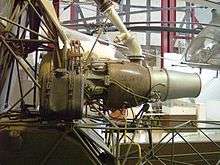Turbomeca Palouste
The Turbomeca Palouste is a French gas turbine engine, first run in 1952.[1] Designed purely as a compressed air generator, the Palouste was mainly used as a ground-based aircraft engine starter unit. Other uses included rotor tip propulsion for helicopters.
| Palouste | |
|---|---|
 | |
| Rolls-Royce license-built Palouste | |
| Type | Gas turbine |
| National origin | France |
| Manufacturer | Turbomeca |
| Major applications | Sud-Ouest Djinn |
Design and development
Designed and built by Turbomeca, the Palouste was also built under license in Britain by Blackburn and Rolls-Royce. Originally conceived as an aircraft ground support equipment starter gas generator, it was used also as propulsion for the Sud-Ouest Djinn and other tip-jet powered helicopters.
The Palouste was a very simple unit, its primary purpose being to supply a high flow rate of compressed air to start larger jet engines such as the Rolls-Royce Spey as installed in the Blackburn Buccaneer (this aircraft having no onboard starting system).[2] Air from the centrifugal compressor was divided between external supply (known as bleed air) and its own combustion chamber.
_c1962.jpg)
Several British naval aircraft were adapted to carry a Palouste in a wing-mounted air starter pod installation to facilitate engine starting when away from base.[3]
A novel use of a surplus Palouste engine was its installation in a custom-built motorcycle known as the Boost Palouste. In 1986 this motorcycle broke an official ACU 1/4 mile speed record at 296 km/h (184 mph)). The builder modified the engine to include a primitive afterburner device and noted that pitch changes which occurred during braking and acceleration caused gyroscopic precession handling effects due to the rotating mass of the engine.
Variants
- Palouste IV
- The gas generator used to power the Sud-Ouest S.O.1221 Djinn and other tip-jet helicopters.
- Palouste IVB[4]
- Palouste IVC[4]
- Palouste IVD[4]
- Palouste IVE[4]
- Palouste IVF[4]
- Palouste 502
- (P.102 and P.104) Blackburn / Bristol Siddeley / Rolls-Royce production for air-starter units.
- Autan
- A development of the Palouste delivering a higher mass flow of compressed air.[5]
- Autan 2
- 1 x axial + 1 x centrifugal compressor stages
Applications
Specifications (Palouste 4)

Data from Flight :BRITISH POWER UNITS 1953,[6][7]
General characteristics
- Type: Gas generator
- Length: 1,233 mm (48.5 in)
- Diameter: 478 mm (18.8 in)
- Dry weight: 90 kg (200 lb)
Components
- Compressor: Single-stage centrifugal flow
- Combustors: Annular combustion chamber
- Turbine: Two-stage axial flow
- Fuel type: Kerosene
- Oil system: Dry sump, pressure sprqay at 300 kPa (43 psi)
Performance
- Maximum power output: 190 hp (140 kW) equivalent air horsepower at 33,000 rpm at sea level
- Overall pressure ratio: 3.8:1
- Air mass flow: 3.5 kg/s (460 lb/min) at 34,000 rpm
- Turbine inlet temperature: TIT 1,070 K (800 °C) ; JPT 793 K (520 °C) at 34,000 rpm
- Fuel consumption: 110 kg/h (240 lb/h)
- Oil consumption: 0.2 kg/h (0.44 lb/h)
- Thrust-to-weight ratio:
- Air output: 1.1 kg/s (150 lb/min) at 350 kPa (51 psi) at 33,000 rpm
See also
Related development
Comparable engines
Related lists
References
- Gunston 1989, p.170.
- "PROVING THE BUCCANEER". Flight International. 81 (2760): 168. 1 February 1962. Retrieved 12 March 2019.
- "Aircraft Ground Power Units.. ". Flight International. 87 (2924): 456. 25 March 1965. Retrieved 12 March 2019.
- Wilkinson, Paul H. (1964). Aircraft engines of the World 1964-65 (20th ed.). Washington D.C.: Paul H. Wilkinson. p. 168.
- Bridgman, Leonard (1955). Jane's all the World's Aircraft 1955-56. London: Jane's all the World's Aircraft Publishing Co. Ltd.
- "BRITISH POWER UNITS 1953". Flight. LXIV (2328). 3 September 1953. Retrieved 12 March 2019.
- Wilkinson, Paul H. (1957). Aircraft engines of the World 1957 (13th ed.). London: Sir Isaac Pitman & Sons Ltd. p. 62.
Further reading
- Gunston, Bill (1998). World encyclopaedia of aero engines (4th ed.). Sparkford, Nr Yeovil, Somerset, [England]: Patrick Stephens. ISBN 978-1852605971.
External links
| Wikimedia Commons has media related to Turbomeca Palouste. |